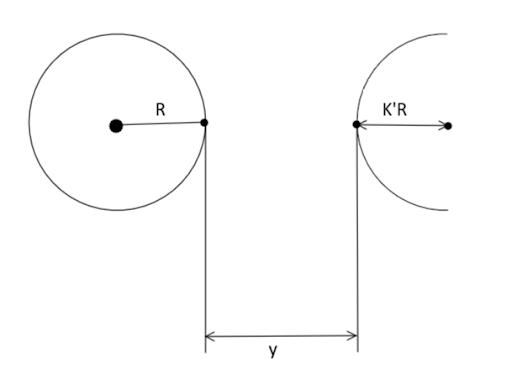
In a cosmic event, suppose a planet heavier than the earth with mass $KM(K > 1)$ and radius $K'R(K' > 1)$ passes through a path near the earth ($M$ and $R$ are the mass and radius of earth). At what closest distance from surface of planet, we are in danger of being thrown into space:

A. ${\left[ {\dfrac{{2KGM}}{g}} \right]^{\dfrac{1}{2}}} - \dfrac{1}{2}K'R$
B. ${\left[ {\dfrac{{KGM}}{{2g}}} \right]^{\dfrac{1}{2}}} - \dfrac{1}{2}K'R$
C. ${\left[ {\dfrac{{KGM}}{g}} \right]^{\dfrac{1}{2}}} - \dfrac{1}{2}K'R$
D. ${\left[ {\dfrac{{KGM}}{g}} \right]^{\dfrac{1}{2}}} - K'R$
Answer
217.5k+ views
Hint: Since the problem is based on gravitational acceleration hence, consider the effect of gravitational force on acceleration due to the gravity of two planets at a distance y from each other. Also, as we all know that the parameters vary with each other hence, analyze every aspect of the solution needed for the question and then present the answer with a proper explanation.
Formula used: The formula of the magnitude of gravitational force due to the Earth is given by:
${F_E} = G\dfrac{{Mm}}{{{R^2}}}$
Here, M is the mass of the earth, R is the radius of the earth and KM is the mass of the heavier planet.
Complete step by step solution:
We know that the magnitude of gravitational force due to the Earth, according to Newton, is given as: -
${F_E} = G\dfrac{{Mm}}{{{R^2}}}$
But also, we have given that KM as mass of the heavier planet and K’R as radius of the heavier planet. Therefore, the magnitude of gravitational force due to the heavier planet will be: -
${F_P} = G\dfrac{{(KM)m}}{{{{(y + K'R)}^2}}}$
Now, if $y$ is the closest distance as shown in the figure. Then, we will be thrown into space if gravitational force due to the heavier planet will become equal to (or greater than) the weight $mg$ i.e.,
$G\dfrac{{Mm}}{{{R^2}}} = mg \\$
$\Rightarrow G\dfrac{{(KM)m}}{{{{(y + K'R)}^2}}} =mg\\$
$\Rightarrow {(y + K'R)^2} = G\dfrac{{(KM)m}}{{mg}} = \dfrac{{KGM}}{g} \\$
Taking square roots on both sides, we get
$y + K'R = \sqrt {\dfrac{{KGM}}{g}} = {\left( {\dfrac{{KGM}}{g}} \right)^{\dfrac{1}{2}}} \\$
$\therefore y = {\left( {\dfrac{{KGM}}{g}} \right)^{\dfrac{1}{2}}} - K'R \\$
Thus, at a closest distance of ${\left[ {\dfrac{{KGM}}{g}} \right]^{\dfrac{1}{2}}} - K'R$ from the surface of the planet, we are in danger of being thrown into space.
Hence, the correct option is D.
Note: This is a conceptual-based problem hence, it is essential that the given question must be analyzed very carefully to give a precise explanation. While writing a solution, support your explanation by providing proper reasons with the help of formulas and scientific relations and correlate the terms used with each other that might help in the solution.
Formula used: The formula of the magnitude of gravitational force due to the Earth is given by:
${F_E} = G\dfrac{{Mm}}{{{R^2}}}$
Here, M is the mass of the earth, R is the radius of the earth and KM is the mass of the heavier planet.
Complete step by step solution:
We know that the magnitude of gravitational force due to the Earth, according to Newton, is given as: -
${F_E} = G\dfrac{{Mm}}{{{R^2}}}$
But also, we have given that KM as mass of the heavier planet and K’R as radius of the heavier planet. Therefore, the magnitude of gravitational force due to the heavier planet will be: -
${F_P} = G\dfrac{{(KM)m}}{{{{(y + K'R)}^2}}}$
Now, if $y$ is the closest distance as shown in the figure. Then, we will be thrown into space if gravitational force due to the heavier planet will become equal to (or greater than) the weight $mg$ i.e.,
$G\dfrac{{Mm}}{{{R^2}}} = mg \\$
$\Rightarrow G\dfrac{{(KM)m}}{{{{(y + K'R)}^2}}} =mg\\$
$\Rightarrow {(y + K'R)^2} = G\dfrac{{(KM)m}}{{mg}} = \dfrac{{KGM}}{g} \\$
Taking square roots on both sides, we get
$y + K'R = \sqrt {\dfrac{{KGM}}{g}} = {\left( {\dfrac{{KGM}}{g}} \right)^{\dfrac{1}{2}}} \\$
$\therefore y = {\left( {\dfrac{{KGM}}{g}} \right)^{\dfrac{1}{2}}} - K'R \\$
Thus, at a closest distance of ${\left[ {\dfrac{{KGM}}{g}} \right]^{\dfrac{1}{2}}} - K'R$ from the surface of the planet, we are in danger of being thrown into space.
Hence, the correct option is D.
Note: This is a conceptual-based problem hence, it is essential that the given question must be analyzed very carefully to give a precise explanation. While writing a solution, support your explanation by providing proper reasons with the help of formulas and scientific relations and correlate the terms used with each other that might help in the solution.
Recently Updated Pages
Elastic Collision in Two Dimensions Explained Simply

Elastic Collisions in One Dimension Explained

Electric Field Due to a Uniformly Charged Ring Explained

Electric Field of Infinite Line Charge and Cylinders Explained

Electric Flux and Area Vector Explained Simply

Electric Field of a Charged Spherical Shell Explained

Trending doubts
JEE Main 2026: Application Form Open, Exam Dates, Syllabus, Eligibility & Question Papers

Derivation of Equation of Trajectory Explained for Students

Hybridisation in Chemistry – Concept, Types & Applications

Understanding the Angle of Deviation in a Prism

Understanding Collisions: Types and Examples for Students

How to Convert a Galvanometer into an Ammeter or Voltmeter

Other Pages
JEE Advanced Marks vs Ranks 2025: Understanding Category-wise Qualifying Marks and Previous Year Cut-offs

Units And Measurements Class 11 Physics Chapter 1 CBSE Notes - 2025-26

NCERT Solutions For Class 11 Physics Chapter 8 Mechanical Properties Of Solids

Motion in a Straight Line Class 11 Physics Chapter 2 CBSE Notes - 2025-26

NCERT Solutions for Class 11 Physics Chapter 7 Gravitation 2025-26

Understanding Atomic Structure for Beginners




